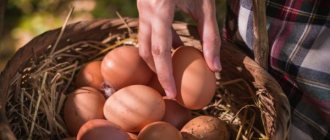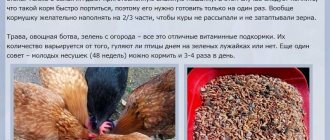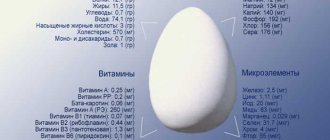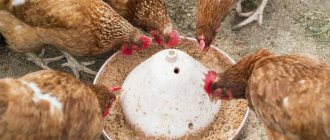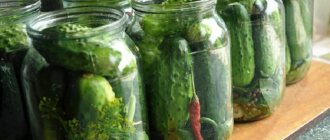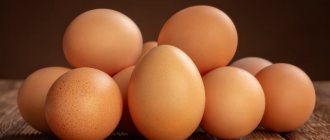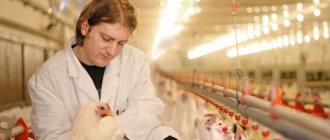973
no comments yet
0
Author of the article
Rasskazov Pavel
Reading time: 6 minutes
The egg production of chickens in the winter depends on various factors. First of all, it depends on the breed and age. Healthy birds of productive age lay eggs all year round. In winter, the intensity of egg laying may drop due to a decrease in daylight hours, low air temperatures, poor microclimate in the chicken coop, decreased chicken activity and feed consumption, slower metabolism, as well as non-compliance with housing and feeding standards.
Chicken coop microclimate
In winter, it is important to maintain optimal humidity and air temperature in the chicken coop. Due to the fact that birds spend most of their time indoors, care should be taken to ensure that the inside is regularly ventilated and heated.
Maintain air humidity at 50-60% and temperature at least 8-12 degrees to ensure good conditions for egg laying. It is important to regularly update the air in the chicken coop without overcooling it. Ideally, install ventilation to ensure good air exchange.
Recipes for preparing food for feeding birds in winter
Winter egg production directly depends on the temperature level in the chicken coop. To ensure that birds do not stop laying eggs, the room temperature should not be lower than 15 degrees Celsius. The lack of heating can be compensated for by nutritious and satisfying food, which is given to chickens in the morning and lunchtime. You can prepare a warm mash from the following ingredients (per 1 feeding per bird):
- boiled potatoes - 50 g;
- grain - 30 g;
- warm water or yogurt - 50-60 g;
- legumes and bran - 6 g each;
- salt - 0.5 g;
- crushed chalk and bone meal - 2 g each;
- fish oil - 1 g;
- grass or cake - 4 g.
You can prepare the mash using meat or fish broth, fermented milk whey or yogurt. The more varied the bird's diet, the more eggs the chicken breeder will be able to collect.
The chicken mash contains several types of food with their nutrients
A mash is a dish that the bird owner can make adjustments to on his own, at his own discretion. Most often, a dish is prepared from what is on hand - vegetables, cereals, grains, peelings. The mash can be either boiled or steamed by simply pouring hot liquid over it. This dish is prepared one at a time so that the product does not spoil.
Waste from the human table is also suitable for feeding chickens, but not everything can be given. Pasta, cereals, dried bakery products, vegetable and fruit peelings, tops, fish heads and offal, meat and bones are suitable for feeding birds. It is not advisable to feed birds leftovers from fatty, spicy, chemical-containing food - this can cause digestive upset.
Feeder for chickens in a poultry house
Video - Methods of germinating wheat for laying hens
Walking hens
It’s worth walking chickens not only to get a sufficient number of eggs, but also to avoid getting a flock full of fat in the spring. After all, obesity is a big problem that is not so easy to solve.
There are several tips for organizing bird walking in winter:
- the air temperature outside should not be below 8-10 degrees below zero;
- You should not let birds out for a walk if there is precipitation or a strong wind is blowing;
- the walking yard needs a bedding of hay, sawdust or sand;
- baths with sand or ash must be present to prevent infection by parasites;
- To prevent frostbite on the scallops and earrings, they are lubricated with Vaseline.
Advice from experienced farmers on keeping laying hens
If you have questions about keeping laying hens in winter in order to increase egg production, you can use the advice of experienced poultry farmers:
- to reduce stress after an attack by a predator on the range, keep the birds locked up for several days;
- the best solution for providing drinking water is to use a vacuum drinker;
- add red hot pepper (20 g) per serving of food to stimulate egg laying; add lemon juice (per 4 liters of water), citric acid or apple cider vinegar (20 drops per 1 liter of water) to the drink;
- feed yeast can be replaced with raw baker's yeast or dry (per 1 kg of feed 10 g of dry or 30 g of fresh yeast);
- place a plastic egg from Kinder Surprise into the nests;
- to ensure high illumination, do not turn off the lights in the chicken coop at night;
- during a seasonal decline, increase the amount of calcium in food, often this helps immediately;
- food (except dry grain) should be cooked only before feeding so that it does not freeze;
- winter walking is necessary even in cold weather; 15 minutes is enough so that the birds do not have time to freeze;
- sprouted grains (corn, wheat) added to the main feed significantly stimulate egg production;
- Whenever possible, add vegetables raw to preserve nutrients;
- Young hens (up to 2 years old) with a young rooster lay eggs better.
Note! By providing your feathered pets with proper conditions, complete and varied food during the cold season, you will regularly collect eggs from clutches.
Feeding
Laying hens feed according to their diet. It is considered very bad if from time to time birds are either overfed or underfed. The same goes for feeding at different times of the day.
Chickens eat no more than 2-3 times a day. Moreover, three meals a day are necessary if it is not possible to often take the chickens out for walks; in other cases, two times a day is sufficient.
In the absence of an established feeding regime, chickens hang around the feeder waiting for the owner to feed them. If feeding occurs consistently at the same time, the hens quickly get used to it and come to the feeding place exactly on schedule.
The first feeding is carried out after the bird wakes up, and in winter, with additional lighting, as soon as the lights turn on.
In the morning, it is more advisable to give mash from boiled potatoes, various ground grains, crushed eggshells and bran, but in winter give a little less mash.
In the evening, chickens are fed an hour before roosting. The time is calculated so that the chickens have time to eat their allotted amount.
Monitor the quality and standards of poultry feeding. The quantity and quality of eggs obtained from laying hens in most cases depend on this. To increase egg production, the following main components are added to the feed:
- Minerals. Mineral supplements are mixed with grain or added to wet mash. They contain fluorine, calcium and zinc. Salt, limestone, shells, and feed chalk are used as such additives.
- Protein. Everyone knows that the bulk of the weight of an egg is the protein. It is found in legumes, oil cake, milk and fishmeal.
- Carbohydrates. This is the main source of energy for the body. Found in potatoes, cereals, vegetables and root vegetables.
- Vitamins. Helps maintain immunity and increase the activity of birds. The breeder can either mix special additives into the food, or use greens, carrots or grass meal.
The largest number of eggs ultimately comes from the bird that has received all the nutrients. For example, on an incorrect diet, a chicken can lay up to 100 eggs, but for each egg she lays, she will spend 500 g of grain, while on the right diet - 250 g. Plus, with an incorrect diet, the eggs are small in size and less tasty .
Feeding standards for birds are drawn up taking into account actual or expected productivity - the greater the egg production of chickens and their weight, the more feed they spend on feeding.
Feeding standards are influenced by many factors, such as the level of productivity, the age of the bird and its weight, time of year and living conditions - young birds need more nutrients, and in winter they need more feed than in summer.
Read more about balanced feeding of laying hens here.
The main mistakes of keeping chickens in winter
The mistakes that poultry house owners make when keeping chickens in winter are as follows:
- violation of the feeding regime and norms - the result is exhaustion due to underfeeding or obesity due to overfeeding;
- mixing different types of grain - birds choose what they like, leaving the rest uneaten;
- an abundance of root vegetables and vegetables in the diet - this supplement should make up only half of the morning feeding, the rest should be grain;
- adding shells in their pure form - the product must be calcined in the oven and ground;
- a cold chicken coop is the reason for a drop in egg production;
- lack of walking in winter - it is necessary to provide chickens with sand, pebbles or gravel;
- spoiled vegetables and green potatoes can cause bird poisoning;
- it is necessary to count the chickens before penning them for the night - a laying hen can lay a clutch in the wrong place and remain outside the chicken coop, where she will be vulnerable to predators;
- a thin layer of plaster when insulating - chickens are able to peck at the walls and pull out the insulation.
Important! It will take a chicken one day to form one egg, and a sign of readiness for laying will be the bright red color of the comb and earrings.
Lighting
Considering that in winter the length of daylight hours is much shorter than in summer, the initial task of the breeder is to artificially increase it. For every 10-12 square meters of the chicken coop there should be at least one 100-watt lamp. Industrial poultry farms use a well-established automatic lighting system for this purpose.
It doesn't matter whether the lights turn on and off automatically or not. It is important to follow the rules for daylight hours and lighting intensity. In winter, chickens are provided with at least 12-14 hours of light so that they can lay eggs normally.
However, do not overdo it with the length of daylight hours, as this can cause exhaustion and premature aging of laying hens.
Factors affecting egg production
Not only the time of year and the breed variety affect the egg production of chickens. Let's consider other factors on which egg production indicators depend:
- Laying hen health status and genetic predisposition. Even representatives of the same breed can show different productivity. After recent illnesses, egg production decreases for some time.
- Age. The first year of laying marks the peak of productivity. Subsequently, there is a gradual decrease in egg production. In this regard, it is recommended to replace the livestock every 2–3 years.
- Shedding. The change of feather cover occurs in autumn. When a chicken molts, the body spends almost all its resources on feather renewal. During this period, some birds do not lay eggs at all, while others' productivity decreases.
- Hatching instinct. If a laying hen has a desire to hatch chicks, she sits on the eggs, then egg laying stops.
- Nutrition. Laying hens need to receive more nutrients and vitamins. If their diet is poor, egg production gradually decreases. Moreover, the quality of eggs deteriorates - they become small, and the shell loses strength.
- Air temperature and humidity. The microclimate in the chicken coop affects the well-being and productivity of the birds. Cold and dampness cause stress in birds, so their egg production drops.
- Lighting in the poultry house. It is so laid down by nature that in the summer, when the days are long, chickens lay eggs more actively, since this time is favorable for procreation. In winter, when there is no light, birds sleep most of the time, which means they receive less food. In such conditions, birds hardly lay eggs.
- Population density. Crowding causes stress in birds, and for this reason, egg production decreases.
Vitamin supplements and minerals
If the bird's diet contains the required amount of minerals and nutrients, its health and productivity levels will significantly improve. These vitamins and minerals include:
- Calcium is involved in the formation of eggshells. There is little calcium in grain, so feed that contains minerals is added to the diet.
- Phosphorus is found in sufficient quantities in eggshells, but before feeding the bird, the shells must be washed, boiled, dried in the oven and ground. Also a valuable source is bone meal, which is made from bones by burning and crushing them.
- Chlorine and sodium. Regular table salt is considered the best source of these elements. For feeding, take only finely ground salt or dissolved salt in water. It affects the taste of feed, making it better, and increases appetite. But be careful, because if used incorrectly, pets may be poisoned.
What can you do to get chickens to lay eggs in winter?
A decrease in egg production in winter can be reduced to the following reasons:
- day length of light;
- number of outdoor walks;
- preparation for hatching;
- cold and poorly lit chicken coop;
- inadequate winter food;
- lack of warm water for drinking;
- anxiety and fatigue;
- health status of chickens.
If these causes are identified and eliminated, the productivity of chickens will not decrease even in cold weather.
Did you know? Chickens can fly, although not far and not for long: the record flight lasted 13 seconds.
Poultry house insulation
Laying hens love comfort, and a well-equipped and insulated chicken coop can provide it. A warm room reduces the energy consumption of birds for heating, they consume less feed and lay eggs better. In this regard, insulating the premises is economically beneficial.
Insulation work should be carried out in the fall:
- seal the cracks in window frames and doors to prevent drafts;
- cover holes in the foundation with putty or clay;
- whitewash the interior walls with lime;
- insulate the outer walls with polystyrene foam, coated with clay and putty;
- insulate the northern part with plant mats;
- ensure freedom of movement and approach to masonry;
- lay the floor with bedding (straw, hay, sawdust);
- Provide heating and additional lighting if necessary.
Such events will make the room warm and dry.
Did you know? Food enters the chicken's stomach by gravity rather than by the swallowing reflex, so birds can only swallow food in an upright position.
Features of feeding chickens
Chicken nutrition in winter differs from summer feeding:
- the winter norm is increased by 15% compared to the summer norm if there is a range;
- the diet should consist of 1/3 protein components and 2/3 carbohydrates;
- vitamin feed is added to mash;
- crushed vegetables, pine needles and hay are introduced in the absence of green mass;
- add sunflower cake and steamed flour;
- water in drinking bowls is given in smaller volumes, but more often and always warm;
- Chickens should eat their food allowance immediately, without leaving it behind to avoid spoilage;
- feeding twice a day in winter (morning and evening);
Evening feeding should be filling, so it is better to feed whole grains at night. All feed components are crushed. When preparing the mash, you can use broths (meat or fish), whey, skim milk or yogurt as a liquid base for dry ingredients (in a ratio of 1:3).
Vitamin supplements
Due to the lack of sunlight in winter, the absorption of vitamins and minerals is reduced, so their replenishment is important when compiling a winter diet to ensure egg production.
The following additives are used for these purposes:
- potassium iodide solution;
- dry herbal mixtures and pine needles;
- dairy products;
- feed chalk;
- meat and bone and blood meal;
- yeast;
- sprouted grain;
- flour from worms and maggots;
- purchased vitamin-mineral complexes (use according to instructions);
- vitamin preparations (“Mi Cal Vit”) for drinking.
Find out what vitamins to give chickens.
Forced shedding
With the arrival of autumn, poultry begins to change feathers, which is called periodic. At this time, the natural process of feather renewal occurs in anticipation of winter. Natural molting takes more than 60 days, while forced molting takes only 45-50. Among the advantages are significant savings in feed, improved quality and weight of eggs, and increased duration of egg production.
In order to stimulate forced molting, a whole range of measures are carried out, including:
- change in diet;
- artificial fasting;
- change in daylight hours;
- increase in body temperature.
Forced molting begins and ends simultaneously for the entire herd. After these procedures, egg production first rapidly decreases and then disappears altogether.
To stimulate the rapid growth of new feathers, intensive fattening of chickens begins. As a result, a new period of egg production begins, which is characterized not only by an increase in egg mass, but also by an increase in the hatchability and viability of the new generation.
Why chickens stopped laying eggs: lack of nutrients
The most important factor in ensuring egg production of chickens is a balanced and nutritious diet. A lack of certain elements or vitamins can lead to a decrease or complete absence of productivity. Feed for laying hens should consist of 60–70% cereal grains. A variety of feeds and a complete combination of useful components (proteins, fats, carbohydrates and vitamins) help to increase egg production.
Sources of protein in the winter diet of chickens are:
- cereal grains (wheat, corn, millet, oats, barley);
- legumes (peas);
- meat and bone and fish meal;
- dairy products (cottage cheese, whey, milk);
- cake and meal (soybean, flax, sunflower, rapeseed);
- vegetables in small quantities.
Source of carbohydrates:
- cereals (especially corn);
- legumes (peas);
- root vegetables (pumpkin, potatoes, beets, carrots);
- flour mixtures and milling waste.
Note! You should not give chickens sweet, salty, sour foods, baked goods, hard watermelon rinds, or fish oil (causes an unpleasant odor to eggs).
How to create a diet for chickens and what are its essential components.
Source of fats:
- corn;
- oats;
- sunflower;
- pumpkin.
Sources of vitamins in winter can be:
- hay dust from herbs;
- needles;
- feed yeast;
- ready-made vitamin supplements.
The formation of the shell is ensured by products containing sufficient amounts of calcium and phosphorus:
- feed chalk;
- shell rock;
- limestone;
- crushed bones;
- crushed egg shells.
Small pebbles or gravel will help to cope with the processing of feed, and thereby improve digestion. Table salt is necessary for chickens - it increases appetite, replenishes the body with sodium and chlorine. There should always be clean, warm water in the drinking bowls. With a lack of water, productivity decreases and the eggs turn out small. Feeding rates should be sufficient to prevent shortages and fights for food. A sudden switch to another type of feed can also cause a lack of eggs.
Requirements for chicken feed:
- high-quality food, not expired;
- the grain is ripened and not pickled, without foreign impurities and dust, without signs of fungus and mold.
Note! When buying ready-made feed for laying hens, it is necessary to study the composition in order to fill the diet of laying hens with the necessary substances.
Age of chickens suitable for egg production
Despite the fact that the life expectancy of chickens is from 12 to 14 years, the most active period of egg production is a young age, up to a year. Fertile individuals are capable of producing up to 300 eggs per year. After a year, egg production decreases by an average of 10%, and after 5-7 years it disappears completely. Periods of complete absence of egg production appear, which are called, as mentioned above, molting.
At large rural enterprises, chickens are kept exclusively for up to a year, precisely during the period of their maximum egg production, and at one and a half years they are sent to slaughter, because there is no financial sense in keeping a bird that produces a small number of eggs or does not lay them at all.
If the farm is smaller, then the owner can keep chickens up to the age of 2 or even 3 years. However, then the chickens are also sent to slaughter, since after 3 years the egg production rates drop much more rapidly than after a year.
As for roosters, they are kept for no more than 4 years, as long as their sexual activity lasts.
At a young age, chickens lay small eggs, which are assigned a low grade (C2 and C3). But nevertheless, these are the eggs that are considered the healthiest.
Is bread suitable for feeding chickens?
It is not recommended to feed laying hens with bread crumbs, since they contain substances that reduce productivity. All rich products made from the highest grade of flour can be harmful to the health of chickens, as they swell greatly in the stomach.
Bread crumbs made from dark flours are also not suitable for feeding poultry. They contain huge amounts of yeast and salt. Due to fermentation processes in the body, laying hens can develop various intestinal diseases.
Spoiled crackers, which have also become covered with mold, are also not suitable for chickens. If they eat them, they may even die from poisoning or intestinal disorder. You should not give laying hens sweet flour products, especially those with various fillings.
Which breed should I choose?
It is often worth taking measures to increase the level of egg production when arranging a chicken coop and choosing chickens. There are certain breeds that are considered very fertile:
- Leghorn broke the record for egg production - 371 eggs in a year. Reproductive age begins at 20 weeks. The downside is that they can't stand the noise.
- Loman Browns have a high level of tolerance to cold climates and have an impressive size, which makes them a good source of meat after the reproductive period.
- Hisex is one of the Leghorn hybrids. Among the advantages: resistant to infectious diseases;
- tolerates low temperatures well;
- not too demanding on the quality of food.
When choosing laying hens, you can be guided by the following criteria: the most egg-laying hens have a small oval head, bright red earrings, a beak bent at the bottom and thick plumage.
Conditions for good egg production
Egg production and egg quality are affected not only by food, but also by the living conditions of laying hens. Let's consider what conditions for keeping birds you need to adhere to:
- Spaciousness. The chicken coop should be arranged in such a way that each bird is allocated approximately 0.2–0.5 m² of area. This is convenient not only for pets, but also for the poultry farmer, since it is easier to clean in a spacious chicken coop.
- Insulation of walls. One of the important stages of preparation for winter, which is aimed at maintaining optimal temperature conditions in the chicken coop, as well as protecting birds from drafts and cold. Insulation needs to be done in the fall - for this they use thermal insulation materials, which are used to cover not only the walls, but also the doors. It is also recommended to insulate the windows with polyethylene film and foam for installation.
- Purity. The chicken coop should be clean and tidy. Cleaning needs to be done frequently. It includes several types: once a week, roosts and nests should be cleaned, and once a month, disinfection work should be carried out in the chicken coop, which should be preceded by general cleaning of the premises (including cleaning windows, collecting cobwebs, etc.). As for drinking bowls and feeders, they need to be cleaned every day.
- Lighting. One of the keys to high egg production. The fact is that light affects the functionality of chicken ovaries, and, accordingly, productivity. Therefore, it is important that the coop has large windows that allow the amount of daylight your pets need to enter. In the autumn and winter, when the length of daylight hours sharply decreases, it is necessary to equip the chicken coop with artificial lighting; You can use fluorescent lamps for these purposes, the light of which is very similar to daylight. Ideally, the chicken should receive light from 6–9 am to 5–8 pm.
- Temperature. The optimal temperature in the chicken coop for good egg production of chickens in winter is approximately 15ºС (fluctuations within 12–18ºС are allowed). A sharp drop in temperature causes birds to lose their plumage and stop laying eggs, so in winter it is advisable to take care of ways to heat the chicken coop. You can use a heat gun, heat lamp, radiator, air conditioner.
- Litter. It is recommended to change the litter every three days. You can use straw or sawdust as it. The optimal thickness of the litter is from 7 to 15 cm.
Important! Make sure the litter is dry. The humidity in the chicken coop should not be allowed to increase, as this can lead to rotting of the litter and the formation of microbes and bacteria in its thickness, which can cause diseases in the birds.
In order for poultry farming to be profitable, it is worth working hard and taking care of the birds. They need to create all the conditions for normal life and productive egg production. This includes setting up a chicken coop and selecting the right nutritional diet, which is especially important in winter.
Video tips for increasing egg production of chickens
We present to your attention a video in which an experienced breeder shares his secrets for improving the egg production of chickens:
When using these tips for improving the egg production of chickens, keep in mind that they only apply to healthy representatives, because there are reasons for a decrease in egg production that have nothing to do with the change of season. And if the problems are related to diseases, then these recommendations will not help solve the problem - then you will need to contact a veterinarian.
0
0
Copy link
Age and health of the bird
The age of the bird itself has a great influence on the quality of eggs.
Chickens have the best fertilization and hatchability of eggs at the age of 2 years; at the age of 3, egg production is significantly reduced, and in young animals it is often completely absent.
With increasing age of laying hens (up to 2.5 years), an increase in the specific and absolute weight of eggs is observed, and the weight of the shell and yolk, as well as the amount of sugar content in them, increases. The latter, in the first days of incubation, plays a huge role in the development of the embryo.
With age (4-5 years), the quality of the shell deteriorates, the egg decreases in size, and the surface becomes porous, which is especially noticeable in the last days of egg production. This leads to a decrease in egg hatchability and a decrease in chick weight at hatching.
Don’t rush to purchase expensive feed and various additives so that your chickens lay eggs well in the winter. Laying hens will continue to delight you with their productivity, especially if their diet is varied, the bedding is warm, and the days are long.
Are courses offered in winter? Features and subtleties of the process in winter
If normal conditions are provided and the laying hens are at an age corresponding to the fertile period, chickens can lay eggs in the winter. However, for this, it is necessary to create a number of conditions that ensure comfortable maintenance of the bird population. In addition, an important factor is the breed of chickens , depending on it, laying hens can:
- reach laying age at an earlier time from birth;
- have greater survival rate;
- lay a larger number of eggs that have a larger mass.
Farmers choose a breed of chickens for breeding taking into account the need for meat or eggs; in the first case, they prefer egg-laying chickens, in the second, a meat-egg breed. In some cases, despite the name, meat-egg breeds provide longer laying of eggs with the weight of each egg in the range of 65-70 g.
Important! Provided the breed is chosen correctly, the lack of laying ability in the winter can be influenced by fatigue.
Starting to lay eggs at the age of 4-7 months, many breeds provide good laying of eggs for 2 years, after which the body ages and a decrease or complete cessation of egg laying occurs. In order to eliminate the factor of fatigue as a reason for termination of laying, it is necessary to regularly rotate birds in the population.
Note! The presence of a young rooster in a bird population can increase the number and duration of clutches, however, this effect lasts for a very short period of time.
improper nest organization as one of the important factors affecting egg laying Their number should be based on no less than one nest per five chickens. The nest should not be located on the floor; it is better to place it in less lit areas of the chicken coop and insulate it with litter, periodically checking the degree of dryness and replacing it as necessary.
Worth knowing! Stressful situations are one of the factors that provoke a decrease or complete disappearance of egg production.
Such factors may include strangers within the chicken coop, loud music, the appearance of other animals in the territory of their residence, or the accumulation of an excessive number of chickens in a small area. The optimal layout of the chicken coop area is considered to be one in which 30-40 chickens are located on no less than 10 m2.
Note! A good solution would be to organize a container with a shell and sand, as well as a separate box with ash.
In addition to the fact that this will provide the chickens with the opportunity to paddle through the listed materials, pecking at shells and ash, the bird will ensure that the body receives the necessary microelements.
One of the possible reasons for the cessation of egg laying is diseases , which usually occur in the winter due to hypothermia. Among the most common ailments, farmers name such pathologies as frostbite, laryngotracheitis and bronchopneumonia. To prevent their occurrence, it is necessary to provide the poultry with a complete diet and optimal microclimate conditions in the chicken coop.
What food should I prepare for the winter?
The issue is worth considering in more detail. What can be harvested on a personal plot? Root crops, melons and hay.
Roots
This refers to carrots, fodder and table beets.
Carrot
If you have the desire and opportunity, you can sow a separate bed specifically for chickens. Choose forage varieties of carrots; their yield is several times higher than ordinary carrots.
It looks pale and tastes slightly bitter. For birds, these characteristics have no meaning; the main thing is that it is a root vegetable with a full range of useful substances.
When storing for storage, make sure that specimens with obvious rot damage are not included; one carrot can cause damage to a large amount of the crop. If the chicken coop is warm, then you can store carrots in it. If the water in the chicken coop freezes, then the root vegetables need to be moved to a warm cellar.
Table beet
All non-standard vegetables can be stored for storage. Of course, except for those with obvious signs of illness. Fodder beets must be sown separately.
In terms of productivity, it is much superior to the table, and in terms of the range of useful substances it is in no way inferior to it. You can store it in piles or in a cellar. To prevent drying out, it is recommended to cover the piles with burlap.
Do not use plastic wrap under any circumstances; the beets will get dirty under it. Root crops must breathe, and the film completely seals the crop.
The amount of this feed should correspond to the number of chickens. On average, it is recommended to plan up to 12–13 kg per laying hen for the winter. These calculations include inevitable weight loss.
Fodder beet is an excellent food for all animals. It is very profitable to sow it; a large harvest is piled into piles, covered with straw and buried in soil. Be sure to make several vents for ventilation. The air duct is made from a bunch of scraps.
Melons
Pumpkin is sown especially for winter food for chickens. This vegetable is perfectly stored until the new harvest and is distinguished by its high quality in composition and amount of vitamins. Pumpkin is stored best of all, the main thing is not to damage its skin during harvesting and storage.
The vegetable should be stored in a basement, cellar or warm outbuilding. If there are a lot of overripe zucchini in the garden, then these plants will also be used as winter food for laying hens.
Practical advice. Zucchini does not last long, use them as food first.
Potato
It is not grown specifically to feed laying hens. Use small discarded or damaged tubers. It should be noted that summer residents are not very fond of adding potatoes to the winter diet of laying hens.
This is due to the fact that food takes a long time to prepare: they need to be washed, filled with clean water, boiled, kneaded, cooled, and only then can they be fed.
This operation will have to be repeated at best every other day. To the costs of physical labor, one should also add monetary losses on energy resources and it will finally become clear why laying hens do not often have to eat boiled potatoes.
Graceful minors
There are three lines of the breed: black Spanish Minorcas, whose gene pool is now almost exhausted, white-silver British and dwarf. The last line is experimental, the maximum weight of dwarf minors does not exceed 1 kg.
Minorca rooster and chickens
For industrial breeding, the British breed standard is currently used. Female British Minorcas weigh on average 2.3-2.5 kg, roosters - from 3.2 to 4. Along with the Rhode Island breed, Minorcas are equally well suited for both egg and meat breeding.
Chickens of the Minorca breed on the range
Minorka eggs are distinguished by the largest weight - up to 80 g. However, only laying hens in the second year of life are capable of producing eggs of such weight. Young animals that have just reached the age of oviposition produce eggs weighing up to 60 g. The egg production of young animals is higher than that of second years and is up to 170 pcs. per year, while individuals in the second year of life are capable of laying a maximum of 140.
A feature of Minorca chickens is the close dependence of productivity on the purity of the breed. Therefore, individuals with signs of deviation are discarded even before the onset of puberty.
Egg breed Minorca chickens Show on page Open in full size
Minorcas (both young and adult chickens) are very sensitive to changes in temperature and humidity. To maintain productivity, it is important to keep livestock in dry and well-insulated poultry houses.
Keeping chickens in a winter poultry house
